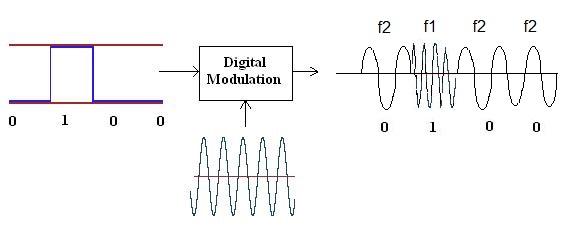

BPSK is coherent as the phase transitions occur at the zero crossing points. GSM cell phones widely use a popular combination, Gaussian filtered MSK (GMSK), which allows a data rate of 270 kbits/s in a 200-kHz channel.īinary Phase Shift Keying (BPSK) And Quadrature Phase Shift Keying (QPSK) A very popular digital modulation scheme, binary phase shift keying (BPSK), shifts the carrier sine wave 180° for each change in binary state ( Fig. Special Gaussian and raised cosine low pass filters are used for this purpose. This rounds the signal off, lengthening the rise and fall times and reducing the harmonic content. Both coherent ASK/OOK and coherent FSK have fewer harmonics and a narrower bandwidth than non-coherent signals.Ī second technique is to filter the binary data prior to modulation. This is called continuous phase or coherent operation. The idea is to synchronize the stop and start times of the binary data with when the sine carrier is transitioning in amplitude or frequency at the zero crossing points. These discontinuities produce glitches that increase the harmonic content and the bandwidth. First, select data rates, carrier frequencies, and shift frequencies so there are no discontinuities in the sine carrier when changing from one binary state to another. Here are two ways to further improve the spectral efficiency for both ASK and FSK. Smaller values are also used such as m = 0.3. A popular version of FSK called minimum shift keying (MSK) specifies m = 0.5. Smaller values of m produce fewer sidebands. T is the bit time interval of the data or the reciprocal of the data rate (1/bit/s). Δf is the frequency deviation or shift between the mark and space frequencies, or: The bandwidth produced is a function of the highest modulating frequency including harmonics and the modulation index, which is: m = Δf(T)


FM produces multiple sideband frequencies above and below the carrier frequency. The bandwidth required is two times the highest frequency content including any harmonics for binary pulse modulating signals.įrequency shift keying (FSK) shifts the carrier between two different frequencies called the mark and space frequencies, or f m and f s (Fig. In Figure 1b, the binary signal turns the carrier off and on to create OOK.ĪM produces sidebands above and below the carrier equal to the highest frequency content of the modulating signal. In Figure 1a, the carrier amplitude is shifted between two amplitude levels to produce ASK.

There are two types of AM signals: on-off keying (OOK) and amplitude shift keying (ASK).
Ask fsk psk difference serial#
These basic modulation forms are still used today with digital signals.įigure 1 shows a basic serial digital signal of binary zeros and ones to be transmitted and the corresponding AM and FM signals resulting from modulation. More sophisticated methods combine two or more of these variations to improve spectral efficiency. There are three basic ways to modulate a sine wave radio carrier: modifying the amplitude, frequency, or phase. Amplitude Shift Keying (ASK) and Frequency Shift Keying (FSK)


 0 kommentar(er)
0 kommentar(er)
